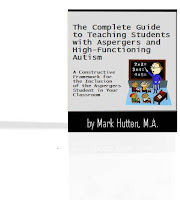For the Aspergers (high functioning autistic) student, schools are full of environmental stimuli that can (a) create a state of anxiety and (b) wreak havoc on his or her sensory sensitivities. Many Aspergers kids are already anxious about wanting to follow the rules, live up to the teacher’s expectations, and get through each day without any major problems.
There have been plenty of studies out there conducted by educational psychologists that show that school settings affect not only those with Aspergers, but other students as well. But keep in mind that the "Aspie" student must also grapple with having her senses assaulted throughout the day. In some instances, if she is not yet a self-advocate, or if she is unaware of her own sensitivities, she may be unable to pinpoint exactly what triggers her anxiety and subsequent loss of control.
Most Aspergers children are keenly aware of the social, educational, and environmental expectation that they “fit in” with the crowd. To compensate, they “keep it together” all day long the best they can. Once they return home, many Aspies breathe a sigh of relief, allow their pent-up stress to explode, and meltdown in the safety of the home environment where they feel most comfortable to let down their defenses. This creates a confusing dilemma for educators who report to moms and dads that their youngster “seems fine” during the day. It also creates a frustrating set of circumstances for moms and dads who may internalize their own self-doubts about “something they must be doing wrong” at home. But it is no one's fault! The Aspergers youngster is simply reacting to the stress-relief that comes with dropping the façade he's been wearing during seven hours of school time.
Here are a few suggestions that parents may want to share with their Aspie’s educators to minimize the stress-inducing “environmental stimuli” that accompanies typical school settings:
1. Partitions around learning stations and computer centers are great for creating visual blocks on both sides of a student and can also cut down some noise.
2. Classroom walls can be over-stimulating and “busy” with decoration. If visuals cannot be streamlined, at least keep them somewhat static so the Aspergers youngster can become accustomed to them.
3. Helping the Aspergers student maintain some element of ‘structure’ during relatively ‘unstructured’ times can be quite helpful. For example, an alternative to being swallowed up by the lunchroom crowd would be to establish “lunch-time discussion” tables in a quieter corner of the cafeteria. Also, some schools assign seating on the bus, which helps alleviate some anxiety experienced by the Aspie when seating is a daily “free for all” and he must compete for seats with older kids.
4. Consider felt pads under the feet of all classroom chairs as buffers against the constant scraping noise they make.
5. Ensure that all children have advance knowledge of schedule changes outside of the routine, such as early dismissal or assemblies.
6. Focus on natural lighting instead of fluorescent lights when possible, using fewer overhead lights or adding alternate lighting such as floor lamps.
7. Many Aspergers kids thrive during those portions of the school day that are structured by routine, but those same children may flounder and feel lost during the many unstructured school events that occur throughout the day (e.g., gym class, hallway socializing between classes, lunchtime, recess, riding the bus to and from school, school assemblies, etc.). As a result, your youngster may be best poised to weather the awkwardness of unstructured school situations if he can volunteer for, or be assigned, a responsibility or role during the activity. For example, many Aspergers children are not as physically adept as they want to be. Playing on a team in gym class can be confusing and uncomfortable, but this can be tempered if he is also in charge of keeping score.
8. Give the Aspergers youngster advance notice of fire-drill times so that he may brace himself for the noise. If he cannot tolerate it, small foam earplugs may help, or wearing iPod or MP3-player headphones may diffuse the noise.
9. Hallways can become extremely noisy (e.g., the echo of footsteps, load conversation, etc.). Wherever possible, keep classroom doors shut.
10. Numbering classroom rules as written reminders for the Aspergers youngster is a good idea, but publicly displaying them on a desktop is stigmatizing. Tape them inside a youngster's notebook or binder and refer to them discreetly.
11. Ringing classroom phones can be startling. Switch to a flashing light instead of a ring to indicate a call.
12. The volume of the PA system in the room may be too loud. If it's possible to adjust the volume, this can help. Same for the change-of-class bell.
For more suggestions on how you, my child's teacher, can make the school-setting more tolerable, please visit MyAspergersChild.com.
Implementing the ideas above may significantly help the Aspergers youngster to “hold it together” in a more environment-friendly school. These methods shouldn’t be seen as “pampering” the Aspie. It just makes sense to poise him for success rather than set him up for failure – especially in light of the fact that he spends the majority of his day at school.



.jpg)


